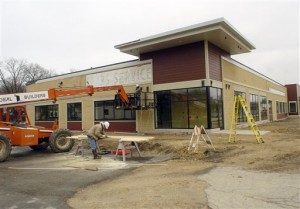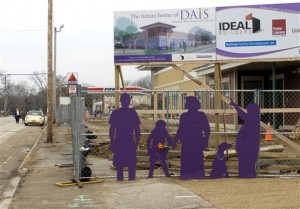Domestic abuse shelters emerge from shadows
By: Associated Press//July 21, 2014//
By GRETCHEN EHLKE
Associated Press

MILWAUKEE (AP) — Domestic abuse shelters, often tucked away in the protective privacy of an obscure neighborhood, have begun moving out of the shadows with more public profiles aimed at generating more community support and better access for victims.
Domestic Abuse Intervention Services in Madison is among the latest to make the move, opening a 56-bed shelter on July 30 in a commercial and high-density residential neighborhood on a bus line and close to health and job placement services used by its clients. The shelter has been in a nearly 100-year-old house in a low-profile neighborhood.
DAIS leaders said they consulted with nearly two dozen shelter programs around the country and visited several in Wisconsin before deciding to move. They learned that abusers were more likely to show up at hidden shelters, and workers and clients felt safer and received more community support in visible locations.
“When the community knows where the shelter is, they’re another set of eyes and ears to make sure people are safe,” said Shannon Barry, DAIS executive director.
Many shelters date to the 1970s, when the problem of domestic violence began to gain attention. Advocates sought to create refuges for victims who can face great risk when they separate from their abusers.
“The thinking at the time was really to create a safe space that an abusive partner couldn’t find,” said Patti A. Seger, executive director of End Domestic Abuse Wisconsin, a Madison-based advocacy organization for victims of domestic abuse. “This is a person who is fleeing danger.”
Many shelters started in houses that blended in with others in residential neighborhoods. They included Wisconsin’s first shelter, Woman and Children’s Horizons, which opened in Kenosha in 1976.
But advocates eventually realized the sense of security provided by a secret location was a bit of an illusion.
“Most shelters wrestle with the reality that over time the community comes to know they are there anyway,” Seger said. “There are many people who transport victims to the shelters — cab drivers, police officers or family members. Over time it often became fairly common knowledge as to the location of the confidential shelter.”
The original shelters were difficult to retrofit to meet accessibility requirements for state and federal funding, and as they aged, operators began looking for newer, larger spaces, advocates said. Greater visibility also seemed to result in more women seeking help and to foster public awareness.
The Harbor House, in Appleton, was one of the first in Wisconsin to make its shelter location known to the public in 1997.
“As we talked to women who were coming to use our service, when we were in a confidential location, they were challenged to find us,” said Beth Schnorr, executive director. With the move, “we got more volunteers, more donations. More people wanted to help,” she said.
The SafeHouse Center, in Ann Arbor, Mich., made a decision to make its location public 10 years ago, putting up a big sign on its building and posting its address on its website. The shelter has high-level security, which its director declined to describe, and is a block from the local sheriff’s office.

“We believe that we’re a part of the community. The embarrassment lies with the assailant, not with the survivor,” said executive director Barbara Niess-May. “Survivors should be lifted up and recognized as part of the community.”
While thinking on shelters and secrecy has changed, laws require safe houses in some states to remain hidden, said Liz Roberts, the chief program officer for Safe Horizon, in New York, one of the largest organizations in the U.S. aiding abuse and crime victims. All of its shelters, which serve 3,000 clients annually, operate in confidential locations, as required by New York State’s Office of Children and Family Services, which issues their licenses.
“One of the realities is that you can’t ever predict with confidence how the situation will develop. Even a case that looks relative low risk … can escalate very quickly,” she said.
Milwaukee’s Sojourner Truth House, which serves about 550 women and children annually at a house in an undisclosed neighborhood, plans to break ground in September on a new shelter at a major intersection near downtown Milwaukee. Executive Director Carmen Pitre said the new shelter will include space for partnering organizations, such as Children’s Hospital of Wisconsin, child welfare workers and Milwaukee police, and “stand as a beacon to other people to get involved in solving the issue” of domestic violence.
Legal News
- Some State Bar diversity participants walk away from program
- Wisconsin court issues arrest warrant ‘in error’ for Minocqua Brewing owner
- Iranian nationals charged cyber campaign targeting U.S. Companies
- Facing mostly white juries, are Milwaukee County defendants of color truly judged by their peers?
- Milwaukee Mayor speaks in D.C. Tuesday at White House water summit
- Chicago man sentenced to prison after being caught with ‘Trump Gun’
- FTC bans non-competes
- Gov. Evers seeks applicants for Dane County Circuit Court
- Milwaukee man charged in dismemberment death pleads not guilty
- Democratic-led states lead ban on the book ban
- UW Madison Professor: America’s child care crisis is holding back moms without college degrees
- History made in Trump New York trial opening statements
WLJ People
- Power 30 Personal Injury Attorneys – Russell Nicolet
- Power 30 Personal Injury Attorneys – Benjamin Nicolet
- Power 30 Personal Injury Attorneys – Dustin T. Woehl
- Power 30 Personal Injury Attorneys – Katherine Metzger
- Power 30 Personal Injury Attorneys – Joseph Ryan
- Power 30 Personal Injury Attorneys – James M. Ryan
- Power 30 Personal Injury Attorneys – Dana Wachs
- Power 30 Personal Injury Attorneys – Mark L. Thomsen
- Power 30 Personal Injury Attorneys – Matthew Lein
- Power 30 Personal Injury Attorneys – Jeffrey A. Pitman
- Power 30 Personal Injury Attorneys – William Pemberton
- Power 30 Personal Injury Attorneys – Howard S. Sicula











